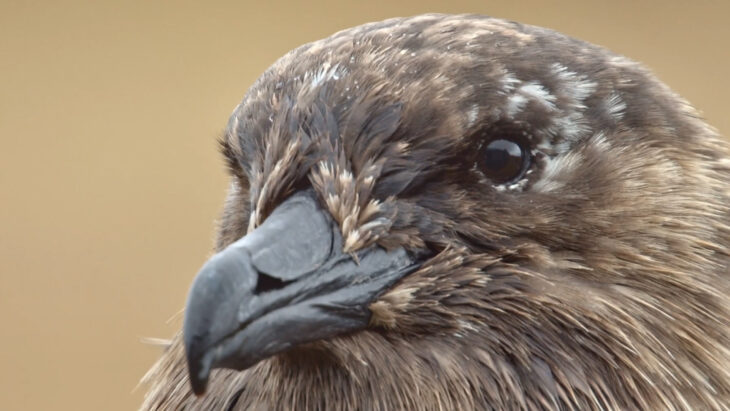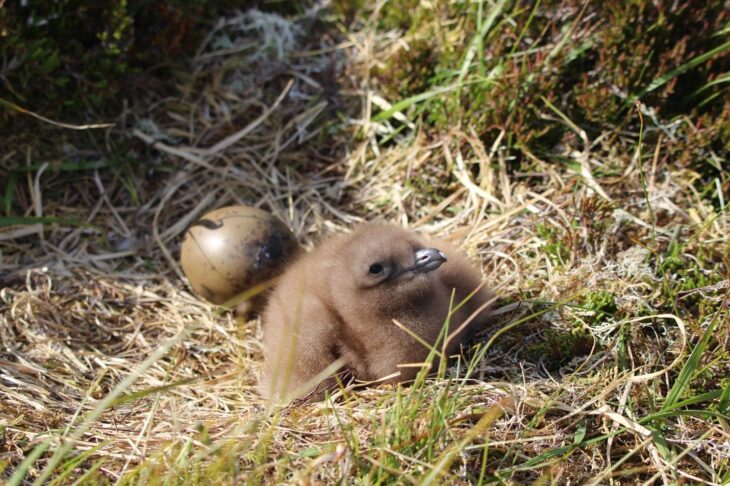In celebration of Handa Island’s great skuas
Pirate. Bully. Villain. These three words have become synonymous with the great skua, one of the summer residents on Handa Island Wildlife Reserve and a part of many other seabird colonies in northern Europe.

I find these titles unsurprising. Any species that predates on one of the world’s most loved birds, the Atlantic puffin, is bound to get a bad reputation. Like every story however, there are always two sides. My mission over the last three seasons on Handa has been to share the fascinating and rarely told tale of this antihero.
Scotland is home to 60% of the global population of breeding great skua, with an incredible 94% of the UK breeding population found on the northern isles of Scotland, the highest concentrations being found on Orkney and Shetland.
Handa is home to a sizeable population. In 2018 an all-island count on Handa counted 283 apparently occupied territories (AOTs), equating to over 560 breeding adults on the island.
This large, powerful seabird is part of the skua family Stercorariidae, and as the name implies it is the largest member of the skua family, although only marginally bigger than its southern hemisphere cousins.
Equally able on land, water and air, the great skua’s thick muscular build and long, broad wings enable agile flight.
Their feet are webbed and equipped with strong, hooked claws at the end of each toe and its large curved beak is used for tearing flesh. It is these adaptations that have earned the bonxie the title of a ‘seabird of prey’, although predation of seabirds only makes up only part of this bird’s extremely varied diet.
After a winter spent in the warmer waters off the Atlantic coasts of France and Spain, the first Handa returnees (usually older individuals) will make landfall in late March.
Like many other seabird species, established breeders will almost always breed with the same mate each year, with both vigorously defending their territories from other skuas, looking to usurp existing occupants or trying to establish a territory of their own.
This competition can lead to fantastic aerial pursuits – filled with twists and turns, dramatic drops in altitude and sudden changes in direction. Conflict instigated on the ground can turn much more violent, with individuals using their sharp beaks and talons to inflict as much damage on their opponent as possible. A good territory is worth fighting for.

The female becomes dependent on her mate soon after returning to the island, relying on him to provide enough food and she prepares her clutch. The first few weeks of the breeding season offer little in the way of food so the birds come prepared with fat reserves. Adults weigh about 25% more than they do after their eggs hatch.
Although she is extremely well hidden when incubating, the female must remain alert as her mate will be out hunting for most of the day and other birds will not miss an opportunity to take an unguarded egg.
While clashes are common between great skuas, the colony will always act as one when larger threats arrive. White-tailed eagles frequent Handa throughout the winter but as the great skua return, the eagles are relentlessly harassed until they are forced away from the colony. Anyone who has walked near to a skua territory during breeding season will know how the eagles feel when under attack!
While it’s easy to sympathise with the great skua’s most charismatic prey I hope I’ve managed to persuade you that these large seabirds are equally fascinating. The next few months on Handa are guaranteed to be filled with excitement as we watch another season progress.
Johnny Rolt, Handa Island Ranger
Help protect Scotland’s wildlife
Our work to save Scotland’s wildlife is made possible thanks to the generosity of our members and supporters.
Join today from just £3 a month to help protect the species you love.
Preface
Pirate. Bully. Villain. These three words have become synonymous with the great skua, one of the summer residents on Handa Island Wildlife Reserve and a part of many other seabird …
